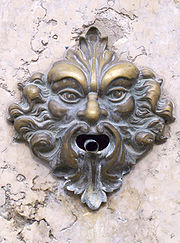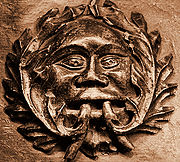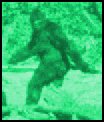
March 17, 2009


Green Men are often represented as garden waterspouts, doorknockers and associated landscape ornaments.
Happy St. Patrick’s Day!

March 17th seems like a good day to talk about Green Men, Jolly Green Giants, and Wild Men traditions.
Let’s look for a moment at the tradition underlying the Green Giant, as it was originally known.
In 1903, Green Giant® was founded in Le Sueur, Minnesota, as the Minnesota Valley Canning Company. In 1925, a boy-like, pale, giant human figure with a leafy bit of clothing was introduced to market the company’s new line of giant sweet, early green peas. The name “Green Giant” for this marketing image soon followed, with the giant figure’s skin then turning green.
Eventually the Green Giant came to symbolize not only the peas, but the company as well. In 1950, Minnesota Valley Canning Company disappeared completely behind the trademark it had created and became officially, the Green Giant Company. Today, the “Jolly Green Giant”® is the name of the giant figure, having evolved from the youthful figure of 1925.
Statue of Jolly Green Giant, Blue Earth, Minnesota.
In our search for the origins of the California Giant in the tales of the California Bigfoot, should we be disturbed that Jolly Green Giants are not running around Minnesota? Perhaps. Perhaps not. First and foremost, the tradition of the Green Giant appears to have a direct link, in terms of artistic imagery, with the folklore and widespread art of the European Green Man.
From ancient times, the archetypal figure shown as the “Green Giant” is commonly referred to as “The Green Man,” or leafy man, and has been discussed throughout European texts, especially in England, and as well as, in France, where it is called Le Feuillou, and in Germany, where it is known as Blattqesicht. Authors have written extensively on the pagan and Celtic traditions of these Green Men, and books and websites about them are abundant.
Scholars, furthermore, see a direct link between the European traditions of the Green Man, and the old tales and encounters with real Wild Men. “The wildman (who may be the same as the ‘green man’),” Myra Shackley notes in her book, Wildmen: Yeti, Sasquatch and the Neanderthal Enigma, “also takes on the role of the spirit of the woods, a kind of pagan nature god…Over 200 European families have wildmen as heraldic emblems, and many more as supporters. Any nude figure in heraldry is called a ‘savage’, ‘wildman’ or ‘woodman’, and the terms are interchangeable. There is little variation in the way they are portrayed, leafy decorations and a club being the rule….Wildmen (or green men) also appear carved in wood and as architectural adornments in the Middle Ages…Green men are frequently shown as a face with foliage emerging from the mouth, and fifty or more of these are known from England alone. The green man is also found carved in stone, as a gargoyle…In the Elizabethan period wildmen, or green men, were often employed to clear the way for processions, wielding sticks.”
Clearly the Green Man comes from the tradition and evolution of the art form of the burly wildmen, the woodsmen, and thus the man of the woods and greenery. Shackley notes: “Wildmen are important figures in medieval paintings and illuminated manuscripts. They may be called ‘wodewoses’ or ‘woodhouses’, and are frequently shown covered with long hair or fur. An additional class of picture shows actors in plays, masques and dramas who are depicted in wildman costumes…The name ‘wodewose’ is derived from the Anglo-Saxon Wudewasa and thence from Wudu (late Old English for wood); Wudewasa seems to mean ‘man-of-the-wood’.…”
The “wildmen” are an active topic in hominology, and some researchers feel the Wildmen and Green Men are a remembrance of Neandertal. As Shackley, Ivan T. Sanderson, and others have noted, we must view the interrelationship between the hairy wildfolk lurking in the remote woodlands of the Middle Ages and the European wildmen, regardless of whether they were called wodewose or green men.
So the graphic transmutation of the survival of late Neandertals in Europe to Wild Men and Green Men, with an artistic connection to the Green Giant and Jolly Green Giant, is worth serious consideration. There appears to be a link between that label on a can of peas in your kitchen and the possible existence of relict hairy hominids, even if uncomfortably so.
Just as the encounters of European wildmen survive in medieval carvings and other graphic representations, so too is the evidence of early-twentieth-century California Bigfoot evident in an artistic form. Depression-era painters appear to have captured the giant hairy hominid on at least one fruit crate label. The containers for lettuce, carrots, and, yes, green peas may have much to teach us in Bigfoot studies, beyond our wildest imaginations.Loren Coleman, from Bigfoot! The True Story of Apes in America (NY: Paraview Pocket – Simon and Schuster, 2003, pages 56-58)

European Wild Man art.
Photo credit for all images above: Wikipedia.
+++
Your support is needed to continue my research, and save the museum. Please donate via PayPal by pushing the button ~ it appears as a long flat untitled box ~ below. It takes you to the right spot at PayPal to contribute, even if you are not a member of PayPal. Blogs are free, but I am on the edge of losing everything. I’m not crying wolf, but there is light at the end of the tunnel, if I can get through until September, when Social Security kicks in. Ten dollars from you means a lot because if everyone gives a little, it gathers the power of numbers. Forestall my foreclosure!!
🙂 Thank You.
About Loren Coleman
Loren Coleman is one of the world’s leading cryptozoologists, some say “the” leading living cryptozoologist. Certainly, he is acknowledged as the current living American researcher and writer who has most popularized cryptozoology in the late 20th and early 21st centuries.
Starting his fieldwork and investigations in 1960, after traveling and trekking extensively in pursuit of cryptozoological mysteries, Coleman began writing to share his experiences in 1969. An honorary member of Ivan T. Sanderson’s Society for the Investigation of the Unexplained in the 1970s, Coleman has been bestowed with similar honorary memberships of the North Idaho College Cryptozoology Club in 1983, and in subsequent years, that of the British Columbia Scientific Cryptozoology Club, CryptoSafari International, and other international organizations. He was also a Life Member and Benefactor of the International Society of Cryptozoology (now-defunct).
Loren Coleman’s daily blog, as a member of the Cryptomundo Team, served as an ongoing avenue of communication for the ever-growing body of cryptozoo news from 2005 through 2013. He returned as an infrequent contributor beginning Halloween week of 2015.
Coleman is the founder in 2003, and current director of the International Cryptozoology Museum in Portland, Maine.
Filed under Abominable Snowman, Almas, Bigfoot, Books, Breaking News, Cryptomundo Exclusive, Cryptotourism, CryptoZoo News, Cryptozoologists, Cryptozoology, Folklore, Sasquatch, Windigo, Yeti, Yowie